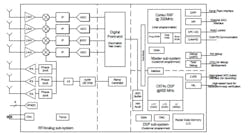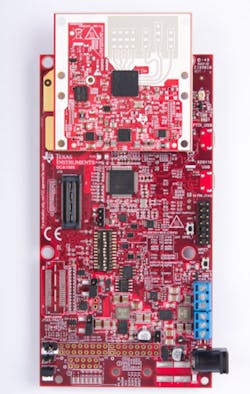It wasn’t that long ago that frequencies above between 5 and 10 GHz were considered impractical for mass-market applications due to challenges with requisite components, materials, layout, and production tolerances. While these frequencies have been widely used for mil/aero, scientific, and other advanced applications, they were viewed as being at the “outer limits” of practicality for consumer and most industrial situations (although some 24-GHz sensing has been in use for applications like industrial fluid-level measurement).
This scenario at the higher range of gigahertz frequencies has changed dramatically due to advances in components as well as in materials and techniques, driven largely by applications such as widespread use of 77/79 GHz for automotive radar. The latest evidence that mass-market products at tens of gigahertz are no longer in forbidden territory comes from Texas Instruments. The company just introduced its 60-GHz IWR6x millimeter-wave (mmWave) sensor portfolio targeting robotics, factory automation, and building automation designs. (60 GHz corresponds to a wavelength of just 5 mm.)
The radar-like functionality of these high-resolution sensors, which integrate significant analog and digital signal-processing capabilities, accelerates a trend to sensing “at the edge.” In other words, it provides up to 4 GHz of ultra-wide bandwidth to detect objects and motion with precision and accuracy up to 20 times more accurate than existing 24-GHz narrowband solutions. TI claims that these FMCW frequency-modulated, continuous-wave (FMCW) mmWave sensors detect objects, people, and motion as minute as breathing and typing, and can separate closely grouped unique objects while reducing false-positive triggers.
1. The IWR6843 family of single-chip transceiver sensors from Texas Instruments exploits the 60- to 64-GHz RF band for high precision and resolution in position- and motion-detection applications.
The IWR6843 and IWR6843AoP single-chip, 60- to 64-GHz sensors are similar, each having three transmitter (10 dBm) and four receiver channels (Fig. 1). The latter device also integrates an antenna-on-package (AoP) to reduce mmWave RF design challenges. Furthermore, each IC includes an integrated fractional-N phase lock loop (PLL); phase noise at 1-MHz offset from 60 to 64 GHz is −92 dBc/Hz. On top of that, there’s an internal 12-bit analog-to-digital converter (ADC) sampling at 25 MHz. The IC’s clock subsystem uses a 40-MHz crystal or an external 40-MHz source.
Considerable processing power exists on the digital side as well. The devices include an ARM Cortex-R4F-based radio-control system with built-in firmware; a self-calibrating system that works across frequency and temperature; a C674x DSP for advanced signal processing; and an ARM R4F microcontroller for object detection and interface control. Other basic digital interfaces include six ADC channels for low sample-rate monitoring; two SPI ports; two UARTs; a CAN-FD Interface; I2C port; general-purpose I/O lines; and a two-lane LVDS interface for raw ADC data-and-debug instrumentation.
2. The IWR6843 modular development platform with software eases the challenging task of developing a properly functioning circuit at the mm-range wavelengths of 60-GHz signals.
Among other features are a scalable software platform, application-specific algorithms, and multiple reference designs. The IWR6843 comes in a 0.65-mm-pitch, 161-pin, flip-chip BGA package measuring 10.4 × 10.4 mm, and requires a combination of 1.2-, 1.3-, 1.8-, and 3.3-V rails. Total power consumption is around 1 A depending on operating mode. The companion IWR6843 modular development platform (IWR6843-STARTER-BDL) is available for US $348 (Fig. 2). TI has also produced some informative tutorial and application information on 60-GHz sensing (see Additional References). Given the rate of progress, can terahertz-band (0.3 to 3 THz or 300 to 3000 GHz, corresponding to 1- to 0.1-mm wavelengths) mass-market sensing be coming soon?
Additional References
SPRY328, “Choosing 60-GHz mmWave sensors over 24-GHz to enable smarter industrial applications”
TIDUE71C, “TIDEP-01000: People Tracking and Counting Reference Design Using mmWave Radar Sensor”
SSZY035, “mmWave radar: Enabling greater intelligent autonomy at the edge”
SPYY005, “The fundamentals of millimeter wave sensors”



